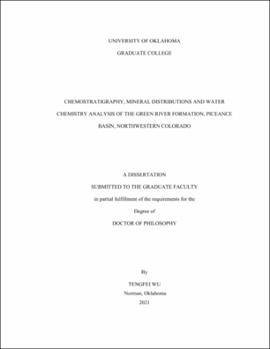| dc.description.abstract | The Eocene Green River Formation (GRF) in the Piceance Basin of Colorado is estimated to contain the largest oil shale deposits in the world and is a well-documented example of a lacustrine depositional system. In addition, the quantities of mineral resources in the oil shale, like nahcolite (NaHCO3) and dawsonite (NaAl(CO3)(OH)2) deposits, are of potential economic value. Detailed geochemical and mineralogical analysis across the basin can be critical to understanding the depositional environment, sedimentary processes and water-chemistry evolution in the basin. Quantitative geochemical data for the GRF were collected by Inductively Coupled Plasma Optical Emission Spectroscopy and Mass Spectrometry (ICP-OES-MS) as part of this study. The basin margin was represented by samples from the Douglas Pass area and the basin center area was characterized by samples of cores from the Shell 23X-2 and John Savage 24-1 wells at the U.S. Geological Survey Core Research Center. Outcrop and core samples were taken based on observed changes of sedimentary structures and lithofacies from the full stratigraphic sections.
Major elements and element groups, (Si, Al, K, Ti), (Ca, Mg), Na, and P were used as proxies for clastic influx, carbonate precipitation, salinity and paleo-productivity, respectively. Trace metal elements (As, Mo, U, Cu, Zn) were used primarily to characterize the redox conditions of Lake Uinta. The changes of these major & trace elements in different lake stages, indicate the variations of the sedimentary components and processes in the lake development. The distinctions between the basin margin and the basin center, in terms of clastic input, salinity, carbonate, paleo-productivity, redox condition and total organic carbon (TOC), support the model of a permanently stratified lake through most of the depositional interval. The detailed geochemistry from this study indicates that Na became elevated earlier in portions of the basin margin than in the deeper basin.
II
During the early stage of lake expansion, the salinity may have been elevated first in the shallow basin margin, because of more efficient evaporation, which then elevated salinity in the basin center through transport of saline density currents. Period IV transition metal elements show only local occurrence of high enrichment, but analysis of Fe/Al ratios suggests that the low enrichments may be related to source rocks depleted in mafic constituents.
Hierarchical clustering analysis (HCA) on these major & trace elements generated 5 chemofacies when integrating all datasets, which represent 1) carbonate facies (high Ca, Mg, Sr and Mn); 2) siliciclastic facies (high Si, Al, K, Ti, Zr, Nb, and P); 3) high TOC with high redox proxies (S, As, Mo, and Cu, etc); 4) saline facies (high Na); 5) mixed carbonate and siliciclastic facies (moderate-high in Ca, Mg, Sr, Mn and Si, K). The chemofacies derived from geochemical data further clarify the depositional environment and sedimentary processes across the basin and provide new perspective on the evolutionary history of the lake. The general coherency of period IV transition metal enrichments/depletions in most chemofacies suggests that, despite lower overall abundances, these elements do reflect the influence of redox conditions in the basin center and the basin margin.
In addition, the distributions of key minerals in the GRF of the Piceance Basin reflect spatial and temporal variations in water chemistry in the paleolake. Mineral stability diagrams generated by thermodynamic modeling constrain the water chemistry under which those minerals were formed. The important minerals identified in the system include analcime, illite, dawsonite, nahcolite and albite/K-feldspar. Based on the mineral stability diagrams, the water chemistry can be defined in terms of silica activity, alkalinity, salinity and CO2 concentration. The Na concentration from the dawsonite and nahcolite stability field can reach 58,000 ppm under hypersaline conditions. | en_US |
